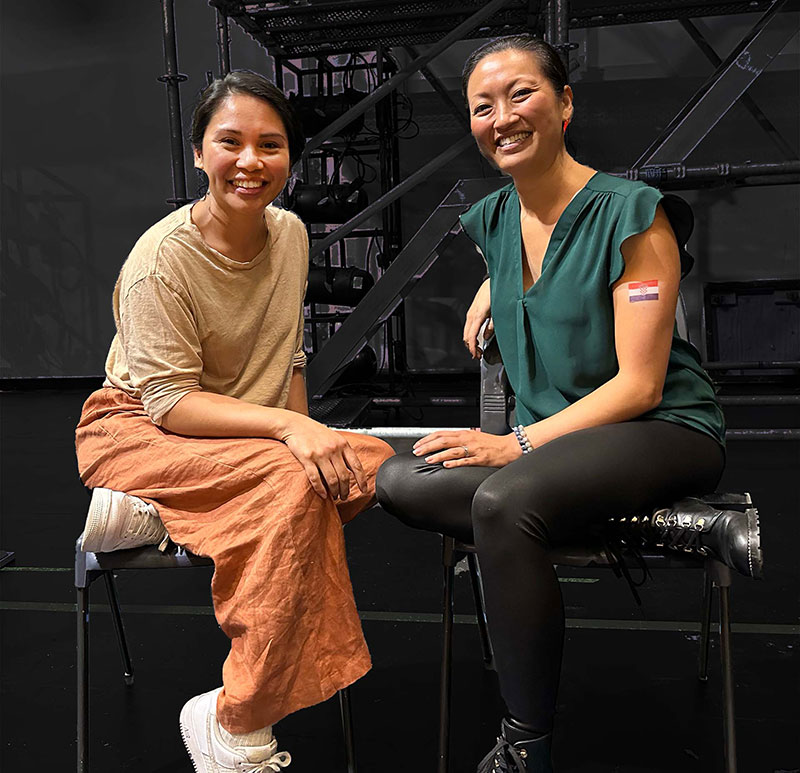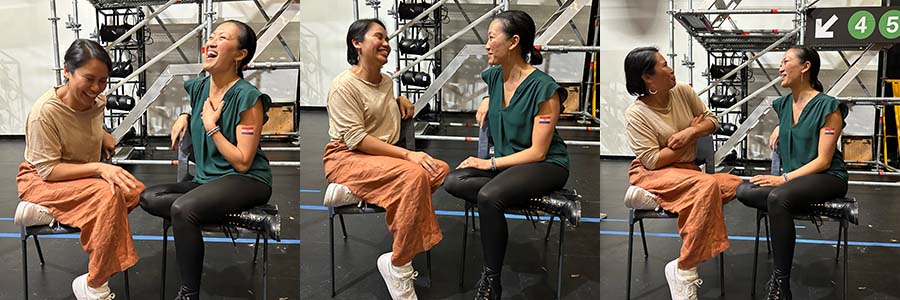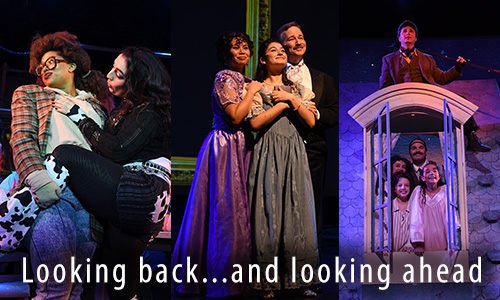The following interview with Jennifer Cuevas and Nicole Tung will appear in the program for SBMT’s upcoming production of RENT. Because it’s a little longer than the typical “Welcome” letter, we are reprinting it here so that patrons can read it before they come to the theater. Jen and Nicole are the co-directors and co-choreographers for the show.
What is your personal history with RENT?
Nicole: The first time that I saw RENT was on Broadway. I had sung along with the soundtrack so many times with my roommates in college and felt like I knew and related to these characters so much. And as a 20- something artist, I felt inspired by these sexy, passionate characters.
Jen: I actually resisted having anything to do with RENT at first. I still had Miss Saigon and Les Miz on my playlist rotation. Thanks to Miss Lea Salonga. There wasn’t any room for this “new sound musical” in my life. However, inevitably, I got curious enough and shelled out the money for the two-CD set. It was the only thing I listened to for a ver-r-ry long time.

The show just felt so cool and was doing so many new things all at the same time: It was rock and opera. It had traditional roots and a modern face. It highlighted homosexuality and a deadly epidemic and–dare I say, celebrated those who were living those lives. That was really bold and exciting—and yes, sexy.
I fell in love with the music instantly. Somehow the music made you want to be these people.
Nicole: Yeah. When I watched the show, I was not prepared for how much it would move me. I still get emotional reflecting on those who lost their lives to HIV/AIDS in the early years of the epidemic when the virus was a death sentence. Thank goodness for medical breakthroughs. They have come a very long way since then. However, I realized at the time, I was more taken in by the rock music and how little I actually had in common with these characters. The show didn’t address the darker issues these characters were facing. Like having to take AZT or struggling to have a roof over their heads. And why didn’t they just get a survival job in order to pay their rent?
Jen: I also saw the show on Broadway, and remember feeling disconnected. It all felt safe and tidy sitting away from the stage as if I were looking into a box. I silently sang every word to every song as I watched, but at some point, I realized I didn’t know what half the songs actually meant.
WTF is AZT? What dignity are they so afraid of losing? And I also wondered, why aren’t they going to pay their rent? Maybe I don’t know enough about these peoples’ lives aside from them singing some really great songs. These characters were indeed beautiful, but I had completely forgotten about the pain and suffering and grasping for survival they were enduring.
What have been your most inspiring influences as you think about the vision of this show?
Nicole: I think for me, looking at the show now with fresh and older eyes, the vision I had for our version is very different than how we probably would have tackled this in our younger years. I think it’s important to bring the HIV/AIDS crisis of the time more to the forefront. Especially because current generations might not know what that experience was for older generations to live through that. I also want to pay homage to some things that are quintessential to NYC that I think might have been missed in the original production.
Jen: I completely agree! I wanted to see if there was a way for us to bring the darker issues to the forefront a bit, and two shows came to mind for inspiration: The Jungle, which I saw at SF’s Curran Theatre and Parade, which I just recently saw in New York. The Curran Theatre ripped out all of its orchestra seating for The Jungle and laid out long planks throughout the space where patrons sat on each side of each plank. All the acting was done amongst the audience. Instantly, the audience became part of the show. Even though you were just an observer, you became involved. It was an amazing experience. For Parade—which was such a beautiful show—the use of projections to educate the audience through pictures and newspaper clippings to help understand the who, what, where of the story was invaluable. I think the projections connected me even closer to the show.
How would you sum up the story of RENT in one word?
Jen/Nicole: Community!
Nicole: It’s kinda crazy how our thoughts are so similar. Freaky.
Jen: Ha ha ha. Twinsies! For real, though. RENT’s community is so passionately filled with culture. It faces disease, homelessness, and addiction. It celebrates people of all shapes, heritages, and genders. It’s through community they are able to find a way to push forward with life, despite life trying to turn its back on them. They have each others’ backs through everything—even during the hardest times. They really have to lean on each other.
Nicole: Totally! I wanted to keep the message of hope, love, and sense of community present throughout this story. Each of us now has the experience of going through the recent COVID pandemic. The isolation, the fear of not knowing what this virus was, the heartbreak, the longing for connection and community. Some of us may also have the experience of being unhoused. The themes of this show still resonate today. So even if we can’t directly relate to the characters, maybe we can relate to the emotions they’re experiencing.
Jen: Yup, and do all that whilst celebrating the kick-ass music. I’m going to have to remind myself to sing along silently.
Nicole: Same.
To learn more about this production of RENT—and get tickets—visit the show’s web page.





Cant wait to see Rent for the first time this Sunday